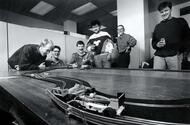The 1990s marked a vibrant chapter in the world of car magazines, a time when the industry was not just about cars, but about culture, competition, and a bit of chaos. If you’ve ever flipped through the glossy pages of a car magazine from that era, you might have sensed the palpable energy and rivalry that defined the landscape. Let’s take a closer look at how this decade shaped automotive journalism and the magazines that became household names.
What Sparked the Battle for Car Magazine Supremacy?
The 1990s were a battleground for car magazines, much like the lads’ mag scene that was also blossoming at the time. While the antics of Loaded and its ilk might have involved more scandal, the car magazine world was rife with its own drama—think subterfuge, fierce egos, and a hefty dose of financial stakes. The stakes were high as major publishers vied for dominance in a lucrative market, leading to a flurry of launches and closures that would shape the future of automotive media.
In January 1993, I found myself stepping into the shoes of James May at Autocar, a publication that had been around since 1895. May had just been dismissed over a minor scandal involving a cheeky word in the Christmas issue, a moment that would foreshadow the unpredictable nature of car journalism. This was a time when the industry was about to undergo a transformation, with new titles emerging to challenge the established players.
How Did the Landscape Change?
To understand the shift, we need to rewind to the 1970s. Car magazine had begun to disrupt the complacency of established weeklies like Autocar and Motor, which were both published by IPC. The rivalry intensified in the 1980s when Haymarket acquired Autocar and subsequently closed Motor. The launch of Auto Express in 1990 signaled the beginning of a new era, but it was the early 1990s that truly ignited the competition.
In 1993, the BBC launched Top Gear magazine, leveraging its television show’s popularity. With a sleek design and a cover featuring every new car in the UK, it quickly captured attention. Meanwhile, Emap was busy developing Carweek and Max Power, the latter of which would go on to outsell its competitors despite initial skepticism from traditional car journalists. Max Power’s irreverent tone and focus on modified cars resonated with a younger audience, proving that there was a market for a different kind of car magazine.
What Were the Highlights of the Era?
The 1990s were a golden age for car enthusiasts, introducing iconic models like the Mazda MX-5, Jaguar XJ220, and McLaren F1. The excitement of new launches and the emergence of brands like Audi and BMW with their sporty models added to the thrill. Car journalists were living the dream, attending launches and test-driving some of the most exhilarating vehicles ever made.
However, the decade wasn’t without its challenges. As magazines experimented with lifestyle content, some traditional publications struggled to maintain their identity. Autocar attempted a bold redesign with a striking yellow masthead, but the shift towards a more lifestyle-oriented approach didn’t sit well with its core audience. Sales dipped, leading to a return to a more traditional look that ultimately proved successful.
What About the Legacy of This Era?
The 1990s also saw the birth of Evo magazine, launched by former Performance Car journalists who believed in the power of high-quality writing and photography. Evo became a beacon for enthusiasts who craved in-depth reviews and stunning visuals, proving that there was still a strong demand for traditional car journalism.
Interestingly, the decade also witnessed the rise of independent publications like Petrolhead, which, despite its short lifespan, left a lasting impact on the automotive media landscape. It even influenced the naming of the popular website PistonHeads, showcasing how interconnected the media world can be.
Reflecting on the 1990s, it’s clear that this era was about more than just cars; it was about the culture surrounding them. The competition between magazines pushed the boundaries of creativity and journalism, resulting in a rich tapestry of content that still resonates with enthusiasts today.
The big takeaway? The evolution of car magazines in the 1990s wasn’t just about the vehicles themselves—it was about how they fit into a broader cultural narrative. Whether you’re a die-hard petrolhead or just someone who appreciates a good story, the legacy of that decade continues to influence automotive journalism. So, if you find an old issue of your favorite car magazine, take a moment to appreciate the history and the passion that fueled it.

